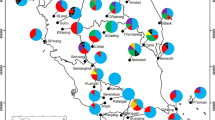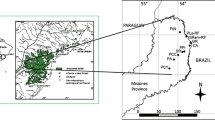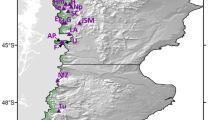Abstract
Currently, many Brazilian orchids are threatened with extinction resulting from habitat loss and intense harvesting pressure stemming from their value as ornamental plants. Therefore, the genetic diversity in remaining populations is fundamental to the survival of these species in natural environments. In order to inform conservation strategies, this study evaluated the genetic diversity and structure of Cattleya granulosa populations. The sample consisted of 151 individuals from 12 populations in the Atlantic Forest, northeastern Brazil, evaluated using 91 ISSR markers. Genetic variability was assessed through molecular variance, diversity indexes, clusters of genotypes through Bayesian analysis, and tests for genetic bottlenecks. From all polymorphic loci, genetic diversity (HE) varied between 0.210 and 0.321 and the Shannon index ranged from 0.323 and 0.472. Significant genetic differentiation between populations (ΦST = 0.391; P < 0.0001) resulted in the division of the populations into five groups based on the log-likelihood Bayesian analysis. We found significant positive correlation between geographical and genetic distances between populations (r = 0.794; P = 0.017), indicating isolation by distance. Patterns of allelic diversity within populations suggest the occurrence of bottlenecks in most C. granulosa populations (n = 8). Therefore, in order to maintain the genetic diversity of the species, the conservation of spatially distant groups is necessary.




Similar content being viewed by others
References
Aguilar R, Quesada M, Ashworth L, Herrerias-Diego Y, Lobo J (2008) Genetic consequences of habitat fragmentation in plant populations: susceptible signals in plant traits and methodological approaches. Mol Ecol 17:5177–5188
Ávila-Diaz I, Oyama K (2007) Conservation genetics of an endemic and endangered epiphytic Laelia speciosa (Orchidaceae). Am J Bot 94(2):184–193
Barbosa AR, Silva-Pereira V, Borba EL (2013) High genetic variability in self-incompatible myophilous Octomeria (Orchidaceae, Pleurothallidinae) species. Braz J Bot 36(3):179–187
Benner MS, Braunstein MD, Weisberg MU (1995) Detection of DNA polymorphisms within the genus Cattleya (Orchidaceae). Plant Mol Biol Rep 13:147–155
Borba EL, Braga PIS (2003) Reproductive biology of Pseudolaelia corcovadensis Porto & Brade (Orchidaceae): melittophyly and selfcompatibility in a basal Laeliinae. Braz J Bot 26(4):541–549
Borba EL, Felix JM, Solferini VN, Semir J (2001) Fly-pollinated Pleurothallis (Orchidaceae) species have high genetic variability: evidence from isozyme markers. Am J Bot 88:419–428
Borba EL, Funch RR, Ribeiro PL, Smidt EC, Silva-Pereira V (2007) Demography, and genetic and morphological variability of the endangered Sophronitis sincorana (Orchidaceae) in the Chapada Diamantina, Brazil. Plant Syst Evol 267:129–146
Brandão MM, Vieira FA, Nazareno AG, Carvalho D (2015) Genetic diversity of neotropical tree Myrcia splendens (Myrtaceae) in a fragment-corridor system in the Atlantic rainforest. Flora 216:35–41
Camara-Neto C, Chaves-Camara I, Medeiros SC, Braga MRA (2007) Rescuing Cattleya granulosa Lindley in the wild. Lankesteriana 7(2):243–246
Case MA, Mlodozeniec HT, Wallace LE, Weldy TW (1998) Conservation genetics and taxonomic status of the rare Kentucky lady’s slipper: cypripedium kentuckiense (Orchidaceae). Am J Bot 85:1779–1786
Chase MW, Cameron KM, Barrett R, Freudenstein JV (2003) DNA data and Orchidaceae systematics: a new phylogenic classification. In: Dixon KW, Kell SP, Barrett RL, Cribb PJ (eds) Orchid conservation. Natural History, Kota Kinabalum, pp 69–90
Chung MY (2009) Lack of allozyme diversity in populations of the rare, endangered terrestrial orchids Tipularia japonica and Epipactis papillosa in Korea. Plant Syst Evol 278:203–209
Cornuet JM, Luikart G (1997) Description and power analysis of two tests for detecting recent population bottlenecks from allele frequency data. Genetics 144:2001–2014
Costa RA (2010) Biologia floral e sistema reprodutivo de Cattleya granulosa Lindl., uma Orchidaceae ameaçada e endêmica do Nordeste do Brasil, p 62. Dissertation—Master Degree in Vegetal Biology, Universidade Federal de Pernambuco, Recife, PE
Cota LG, Vieira FA, Melo-Júnior AF, Brandão MM, Santana KNO, Guedes ML, Oliveira DA (2011) Genetic diversity of Annona crassiflora (Annonaceae) in northern Minas Gerais State. Genet Mol Res 10:2172–2180
Couvet D (2002) Deleterious effects of restricted gene flow in fragmented populations. Conserv Biol 16:369–376
Cozzolino S, Cafasso D, Pellegrino G, Musacchio A, Widmer A (2003) Fine-scale phylogeographical analysis of Mediterranean Anacamptis palustris (Orchidaceae) populations based on chloroplast minisatellite and microsatellite variation. Mol Ecol 12:2783–2792
Cruz DT, Borba EL, van den Berg C (2003) O gênero Cattleya no estado da Bahia. Sitientibus 3(1–2):28–36
Cruz DT, Selbah-Schnadelbach A, Lambert SM, Ribeiro PL, Borba EL (2011) Genetic and morphological variability in Cattleya elongata Barb. Rodr. (Orchidaceae), endemic to the campo rupestre vegetation in northeastern Brazil. Plant Syst Evol 294:87–98
Doyle JJ, Doyle JL (1987) A rapid DNA isolation method for small quantities of fresh tissues. Phytochem Bull Bot Soc Am 19:11–15
Earl DA, vonHoldt BM (2012) Structure Harvester: a website and program for visualizing Structure output and implementing the Evanno method. Conserv Genet Resour 4(2):359e361
Evanno G, Regnaut S, Goudet J (2005) Detecting the number of clusters of individuals using the software STRUCTURE: a simulation study. Mol Ecol 14:2611–2620
Excoffier L, Lischer HEL (2010) Arlequin suite ver 3.5: a new series of programs to perform population genetics analyses under Linux and Windows. Mol Ecol Resour 10:564–567
Fajardo CG, Vieira FA, Molina WF (2014) Interspecific genetic analysis of orchids in Brazil using molecular markers. Plant Syst Evol 300:1825–1832
George S, Sharma J, Yadon VL (2009) Genetic diversity of the endangered and narrow endemic Piperia Yadonii (Orchidaceae) assessed with ISSR polymorphisms. Am J Bot 96(11):2022–2030
Godwin ID, Aitken EAB, Smith LW (1997) Application of inter simple sequence repeat (ISSR) markers to plant genetics. Electrophoresis 18:1524–1528
Gustafsson S (2000) Patterns of genetic variation in Gymnadenia conopsea, the fragrant orchid. Mol Ecol 9:1863–1872
Hamrick JL, Godt MJW (1996) Effects of life history traits on genetic diversity in plant species. Philos Trans R Soc Lond B Biol Sci 351:1291–1298
Hartl DL, Clark AG (2007) Principles of population genetics. Sinauer Associates, Sunderland
Jump AS, Penuelas J (2006) Genetic effects of chronic habitat fragmentation in a wind-pollinated tree. Proc Natl Acad Sci USA 103(21):8096–8100
Kimura M, Crow J (1964) The number of alleles that can be maintained in a finite population. Genetics 49:725–738
Kimura M, Otha T (1978) Stepwise mutation model and distribution of allelic frequencies in a finite populations. Proc Natl Acad Sci USA 75:2868–2872
Kingston N, Waldren S, Smyth N (2004) Conservation genetics and ecology of Angiopteris chauliodonta Copel. (Marattiaceae), a critically endangered fern from pitcairn Island, South Central Pacific Ocean. Biol Conserv 117:309–319
Lee S-L, Ng KKS, Saw L-G, Norwati A, Salwana MHS, Lee C-T, Norwati M (2002) Population genetics of Intsia palembanica (Leguminosae) and genetic conservation of virgin jungle reserves in Peninsular Malaysia. Am J Bot 89(3):447–459
Li A, Ge S (2006) Genetic variation and conservation of Changnienia amoena, an endangered orchid endemic to China. Plant Syst Evol 258:251–260
Li A, Luo Y, Ge S (2002) Premilary study on conservation genetics of an endangered orchid (Paphiopedilum micranthum) from southwestern China. Biochem Genet 40:195–201
Loveless MD, Hamrick JL (1984) Ecological determinants of genetic-structure in plant-populations. Annu Rev Ecol Evol Syst 15:65–95
Luikart G, Allendorf FW, Cornuet JM, Sherwin WB (1998) Distortion of allele frequency distributions provides a test for recent population bottlenecks. J Hered 89(3):238–247
Martinelli G, Moraes MA (2013) Livro vermelho da flora do Brasil. Instituto de Pesquisas Jardim Botânico do Rio de Janeiro, Rio de Janeiro
McCune B, Mefford MJ (1999) Multivariate analysis of ecological data. Gleneden Beach, Oregon
McDermott JM, McDonald BA (1993) Gene flow in plant pathosystems. Annu Rev Phytopathol 31:353–373
Ministério do Meio Ambiente (2008) Instrução normativa n° 6 de 23 de setembro de 2008. http://www.mma.gov.br/estruturas/179/_arquivos/179_05122008033615.pdf. Accessed 07 July 2016
Nei M (1987) Molecular evolutionary genetics. Columbia University Press, New York
Niknejad A, Kadir MA, Kadzimin SB, Abdullah NAP, Sorkheh K (2009) Molecular characterization and phylogenetic relationships among and within species of Phalaenopsis (Epidendroideae: Orchidacheae) base on RAPD analysis. Afr J Biotechnol 8:5225–5240
Nybom H (2004) Comparison of different nuclear DNA markers for estimating intraspecific genetic diversity in plants. Mol Ecol 13:1143–1155
Nybom H, Bartish IV (2000) Effects of life history traits and sampling strategies on genetic diversity estimates obtained with RAPD markers in plants. Perspect Plant Ecol Evol Syst 3(2):93–114
Oliveira DA, Melo-Júnior AF, Brandão MM, Rodrigues LA, Menezes EV, Ferreira PRB (2012) Genetic diversity in populations of Acrocomia aculeata (Arecaceae) in the northern region of Minas Gerais, Brazil. Genet Mol Res 11(1):531–538
Pansarin ER, Amaral MCE (2008) Reproductive biology and pollination mechanisms of Epidendrum secundum (Orchidaceae). Floral variation: a consequence of natural hybridization? Plant Biol 10:211–219
Parab GV, Krishnan S (2008) Assessment of genetic variation among populations of Rhynchostylis retusa, an epiphytic orchid from Goa, India using ISSR and RAPD markers. Indian J Biotechnol 7:313–319
Parab GV, Krishnan S, Janarthanam MK, Sivaprakash KR, Parida A (2008) ISSR and RAPD markers assessed genetic variation of Aerides maculosum—an epiphytic orchid from Goa, India. J Plant Biochem Biotechnol 17(1):107–109
Peakall R, Smouse PE (2006) GENALEX 6: genetic analysis in Excel. Population genetic software for teaching and research. Mol Ecol Notes 6:288–295
Pinheiro LR, Rabbani ARC, Silva AVC, Lédo AS, Pereira KLG, Diniz LEC (2012) Genetic diversity and population structure in the Brazilian Cattleya labiata (Orchidaceae) using RAPD and ISSR markers. Plant Syst Evol 298:1–11
Pritchard JK, Stephens M, Donnelly P (2000) Inference of population structure using multilocus genotype data. Genetics 155:945–959
Qian X, Wang C-X, Tian M (2013) Genetic diversity and population differentiation of Calanthe tsoongiana, a rare and endemic orchid in China. Int J Mol Sci 14(10):20399–20413
Rodrigues JF, van den Berg C, Abreu AG, Novello M, Veasey EA, Oliveira GCX, Koehler S (2015) Species delimitation of Cattleya coccinea and C. mantiqueirae (Orchidaceae): insights from phylogenetic and population genetics analyses. Plant Syst Evol 301:1345–1359
Sharmaa IK, Jonesa DL, Younga AG, French CJ (2001) Genetic diversity and phylogenetic relatedness among six endemic Pterostylis species (Orchidaceae; series Grandiflorae) of Western Australia, as revealed by allozyme polymorphisms. Biochem Syst Ecol 29:697–710
Silva-Pereira V, Smidt EC, Borba EL (2007) Isolation mechanisms between two sympatric Sophronitis (Orchidaceae) species endemic to Northeastern Brazil. Plant Syst Evol 269(3–4):171–182
Soto Arenas MA, Solano Gómez R, Hágsater E (2007) Risk of extinction and patterns of diversity loss in Mexican orchids. Lankesteriana 7:114–121
Sun M, Wong KC (2001) Genetic structure of three orchid species with contrasting breeding systems using RAPD and allozyme markers. Am J Bot 88:2180–2188
Swarts ND, Dixon KW (2009) Terrestrial orchid conservation in the age of extinction. Ann Bot 104:543–556
Toro MA, Caballero A (2005) Characterization and conservation of genetic diversity in subdivided populations. Philos Trans R Soc Lond B Biol Sci 360(1459):1367–1378
Trapnell DW, Hamrick JL (2005) Mating patterns and gene flow in the neotropical epiphytic orchid, Laelia rubescens. Mol Ecol 14:75–84
Trapnell DW, Hamrick JL, Nason JD (2004) Three-dimensional fine-scale genetic structure of the neotropical epiphytic orchid, Laelia rubescens. Mol Ecol 13:1111–1118
Trapnell DW, Hamrick JL, Ishibashi CD, Kartzinel TR (2013) Genetic inference of epiphytic orchid colonization; it may only take one. Mol Ecol 22:3680–3692
Ueno S, Rodrigues JF, Alves-PereiraA Pansarin ER, Veasey EA (2015) Genetic variability within and among populations of an invasive, exotic orchid. AoB Plants 7:plv077. doi:10.1093/aobpla/plv077
Vale Á, Rojas D, Álvarez JC, Navarro L (2013) Distribution, habitat disturbance and pollination of the endangered orchid Broughtonia cubensis (Epidendrae: Laeliinae). Bot J Linn Soc 172(3):345–357
Van den Berg C (2014) Reaching a compromise between conflicting nuclear and plastid phylogenetic trees: a new classification for the genus Cattleya (Epidendreae; Epidendroideae; Orchidaceae). Phytotaxa 186(2):075–086
Van den Berg C, Higgins W, Dressler R, Whitten W, Soto-Arenas M, Chase MA (2009) Phylogenetic study of Laeliinae (Orchidaceae) based on combined nuclear and plastid DNA sequences. Ann Bot 104:417–430
Velozo HP, Rangel-Filho ALR, Lima JCA (1991) Classificação da vegetação brasileira adaptada a um sistema universal. IBGE, Rio de Janeiro
Vieira FA, Carvalho D (2008) Genetic structure of an insect-pollinated and bird-dispersed tropical tree in vegetation fragments and corridors: implications for conservation. Biodivers Conserv 17:2305–2321
Wallace LE (2003) Molecular evidence for allopolyploid speciation and recurrent origins in Platanthera huronensis (Orchidaceae). Int J Plant Sci 164:907–916
Wallace LE (2004) A comparison of genetic variation and structure in the allopolyploid Platanthera huronensis and its diploid progenitors, Platanthera aquilonis and Platanthera dilatata (Orchidaceae). Can J Bot 82:244–252
Wright S (1951) The genetical structure of populations. Ann Eugen 15(4):313–354
Yeh FC, Yang RC, Boyle TBJ, Ye ZH, Mao JX (1997) POPGENE, the user-friendly shareware for population genetic analysis. Molecular Biology and Biotechnology Center, University of Alberta, Edmonton
Young A, Boyle T, Brown T (1996) The population genetic consequences of habitat fragmentation for plants. Trends Ecol Evol 11(10):413–418
Acknowledgements
We thank the Coordenação de Aperfeiçoamento de Pessoal de Nível Superior (CAPES) for providing a doctoral fellowship to C.G. Fajardo. This work was supported by Conselho Nacional de Desenvolvimento Científico e Tecnológico (CNPq, Brazil). We would like to acknowledge J. Felismino, R. Costa, E. Mendonça, J. G. Jardins, Julião from the Reserva Biológica Guaribas, and V. G. Pinto from Cristal Mineração do Brasil LTDA for providing research facilities for field work. We thank Dr. Evelyn Nimmo for editing the English of the manuscript.
Author information
Authors and Affiliations
Corresponding author
Additional information
Communicated by Daniel Sanchez Mata.
This article belongs to the Topical Collection: Forest and plantation biodiversity.
Electronic supplementary material
Below is the link to the electronic supplementary material.
Supplementary material 1
Estimates of Nei’s genetic distance (1978), below the diagonal, and geographic distance (Km) above the diagonal, between the populations of Cattleya granulosa. The minimum and maximum values are shown in bold. (DOCX 28 kb)
Supplementary material 2
Principal component analysis of populations of C. granulosa based on the Nei’s genetic identity. tatistics (B). Populations are bounded by black vertical bar. (DOCX 55 kb)
Supplementary material 3
Plotting of the mean LnP(D) values from the Bayesian approach (full line) and Evanno’s ΔK (broken line). Error bars are standard deviations of LnP(D) values. (DOCX 27 kb)
Rights and permissions
About this article
Cite this article
Fajardo, C.G., de Almeida Vieira, F., Felix, L.P. et al. Negligence in the Atlantic forest, northern Brazil: a case study of an endangered orchid. Biodivers Conserv 26, 1047–1063 (2017). https://doi.org/10.1007/s10531-016-1285-5
Received:
Revised:
Accepted:
Published:
Issue Date:
DOI: https://doi.org/10.1007/s10531-016-1285-5




